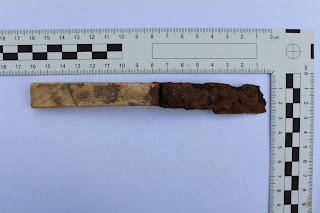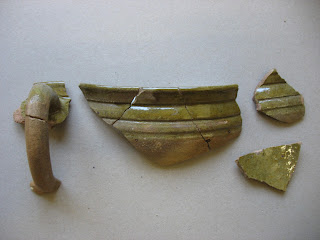We are excited to report that a new project is on the horizon. As meetings are being arranged we can't give out any details yet, but this would be an archaeology project on an important national heritage site.
Monday 4 October 2021
Saturday 11 September 2021
Season's End
Fancy a tipple?
Tuesday 7 September 2021
Keep it buttoned
Special Find of the Day:
In 1774 a foul anchor surrounded by rope
edging took the place of a rose and in 1787 the same device, with the addition
of a wreath of laurel leaves, was adopted for Admirals. When the Merchant Navy
started to use the foul anchor device a crown was added for all naval officers
in 1812. The same basic design remains in use today.
The
foul anchor device itself was first recorded in use in the seal of the Lord
High Admiral of Scotland in 1402. It was subsequently adopted in the Admiralty
seal and by a large number of navies throughout the world. The rope 'fouling'
has no specific twist and may be deemed to be correct however it fits around
the anchor.
It is nice to think that someone from the navy visited Stalbridge House and then lost a button!
Monday 6 September 2021
Get stuck in
- Early 17th century - Forks became commonplace across Europe as a tool of steadying food while cutting, and in a lesser case for providing easier transfer of solid food between the plate and mouth. Majority of people still used sharply pointed knives for that purpose.
- 1630 - Forks and blunt tipped knives start arriving at colonies in North America.
- 1669 - French King Louis XIV of France banned the use of sharp tipped knives in France as a means of reducing violence. This introduced new era of blunt tipped eating knives.
Thursday 26 August 2021
Book
'A Digger's Life: trowels & tribulations in archaeology' is available on Kindle via Amazon Books.
Chris Tripp has dug into his personal archaeological story to tell how he has touched the past. He describes how and why he became a professional archaeologist and began excavating fascinating sites, finding wonderful artefacts and experiencing the deeper past during a thirty year career. How he saw Roman London’s first beginnings, unearthed a medieval hospital and exhumed a Bronze Age skeleton. Meet his fellow diggers, some friendly, some not so friendly and some just eccentric, but all equally interesting to know. Chris also began his work with local communities, helping them find the heritage they share under their feet. If you have ever wondered what diggers really do and why they do it, this book will give you a unique insight into the small world of archaeology and archaeologists, to the extent that you will never watch ‘Time Team’ in the same way ever again.
Saturday 21 August 2021
Trench trial
Friday 20 August 2021
Finds Found
Saturday 31 July 2021
Pottery Lottery
Tuesday 27 July 2021
Wall Walk
Saturday 24 July 2021
Balust-raid
Thursday 22 July 2021
Bedrock, but no Flintstones!
Baluster Bonus
Sunday 18 July 2021
If you can't fight ...
Saturday 17 July 2021
Egg & Cup for Breakfast
De-cellar-ration
Wednesday 7 July 2021
Thursday 1 July 2021
Sunday 27 June 2021
Cellar-brations?
AGM 2024
The DDCAG AGM took place and we discussed the forthcoming sites that we will be working on this year. The DMV in East Dorset was presented ...
-
Martin (left) and WDDAG WDDAG visited Martin Green's Down Farm this weekend, and what an experience it was! He took us through ...
-
This is a little film about how to distinguish between natural flint and human made tools. If you have found anything that you may think ...
-
Dorset Diggers Community Archaeology Group: Finding Flints : This is a little film about how to distinguish between natural flint and hum...





















































